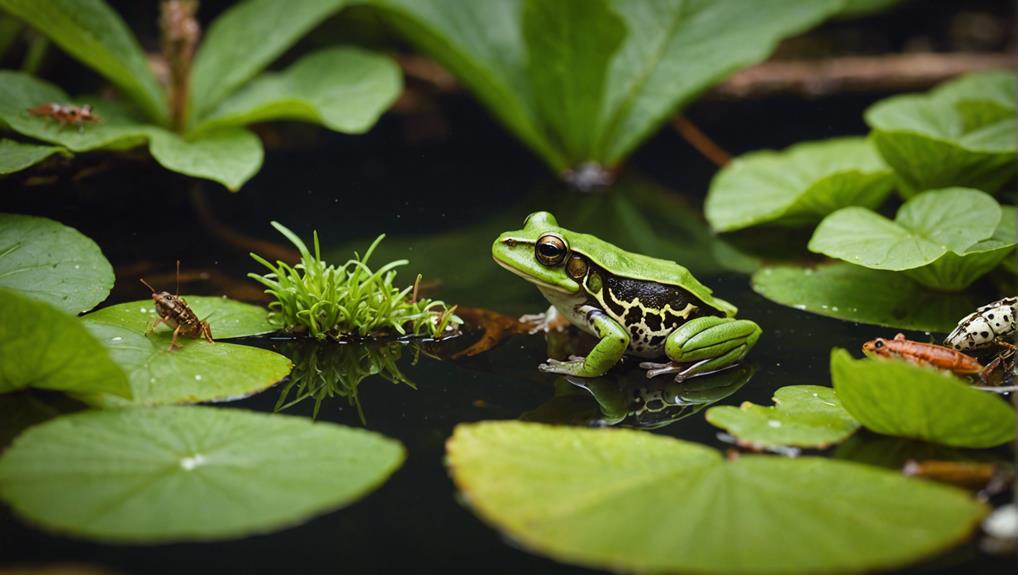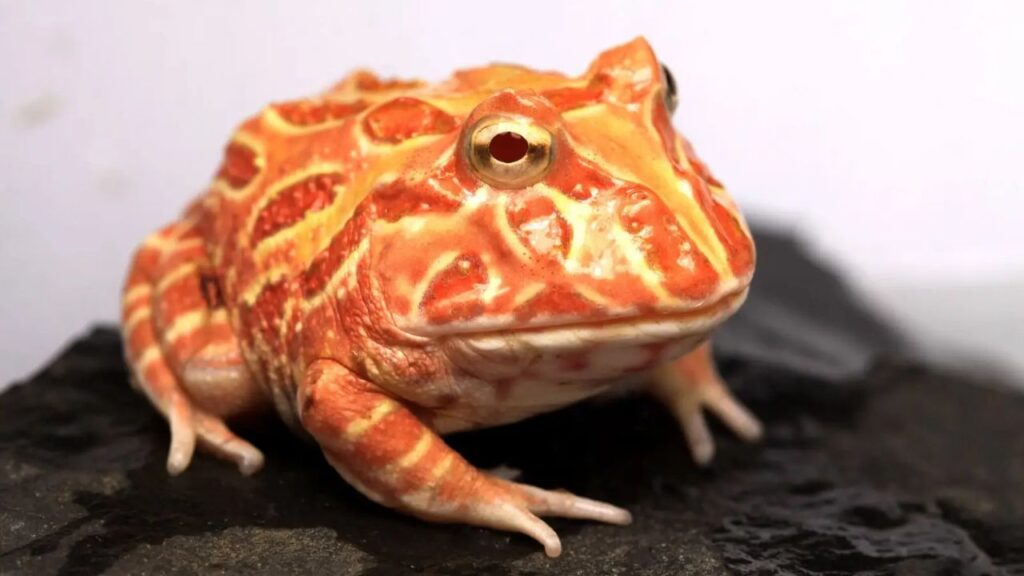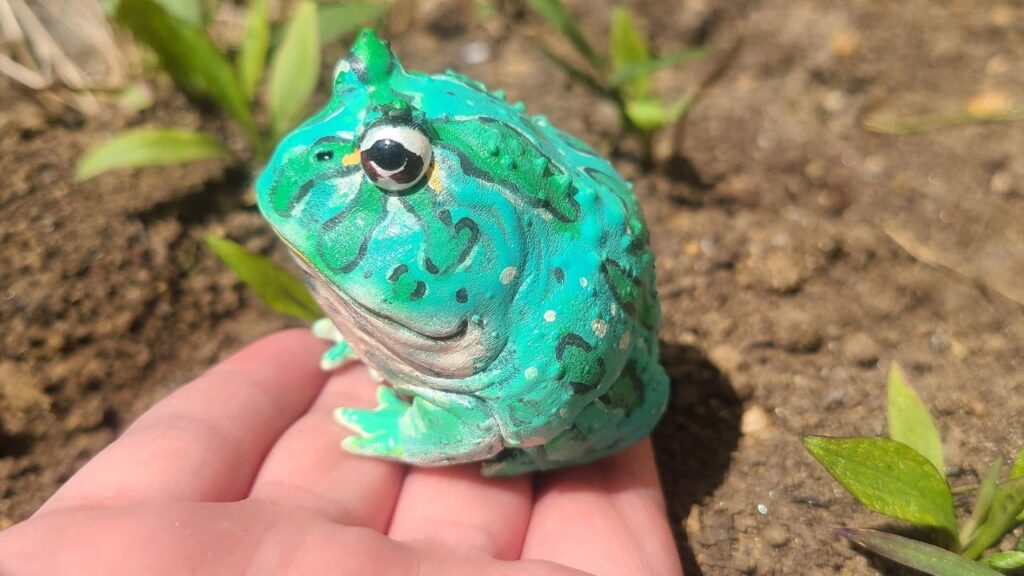You must feed baby frogs a balanced diet of nutrient-rich, easily digestible food to support their rapid growth. Start with small, soft-bodied insects like pinhead crickets and ant larvae. Ensure the food is no larger than the space between the froglet’s eyes to avoid choking.
Supplements like vitamin powders and calcium are essential for bone and overall health. Feed them two to three times a day and remove uneaten food to maintain a clean environment.
Avoid toxic foods like wild-caught insects and hard exoskeletons. Monitoring their growth and health is also important—stay tuned for more tips.
Importance of Proper Nutrition
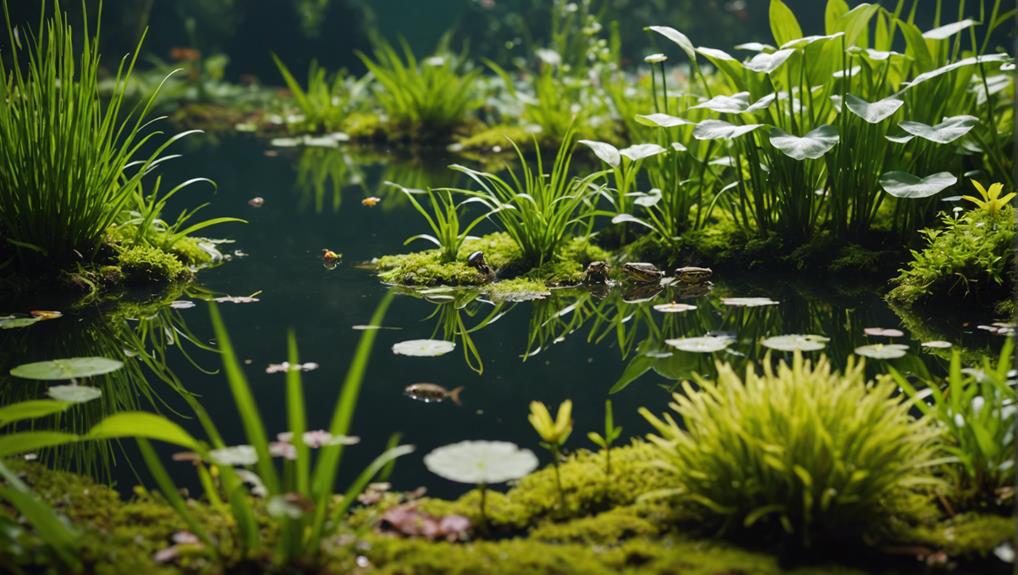
A baby frog’s proper nutrition is essential for its growth and development. As someone who cares about the well-being of these tiny creatures, you’ll want to ensure they get the best start in life.
During their early growth stages, baby frogs undergo significant transformations, and their nutritional needs change accordingly. By understanding these needs, you can help them thrive.
The primary focus should be on providing a balanced diet that supports their rapid growth and efficient nutrient absorption. A baby frog’s digestive system is still developing, so it’s crucial to offer food that’s easily digestible and nutrient-rich.
This ensures that their bodies can absorb the necessary nutrients to support their growth stages effectively.
You should pay attention to the size and type of food you provide, as baby frogs have small mouths and specific dietary requirements.
By offering the right kind of nourishment, you help them build strong bones, develop healthy organs, and maintain their energy levels. Proper nutrition not only promotes physical growth but also boosts their immune system, making them less susceptible to diseases.
Ensuring baby frogs receive the right nutrients is a vital part of supporting their overall health and well-being.
Natural Diet of Baby Frogs
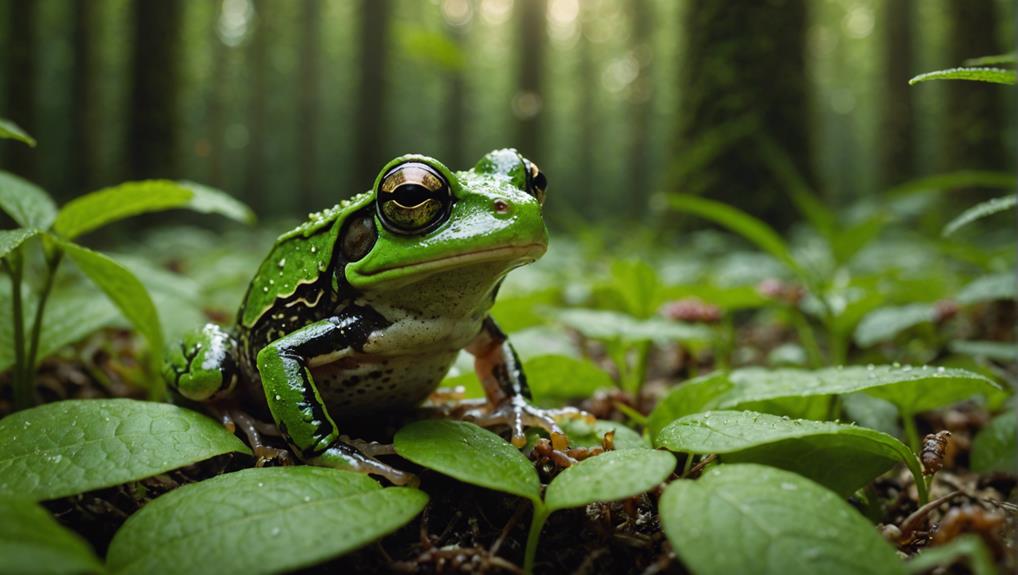
Understanding what baby frogs eat in their natural habitat can guide you in replicating a diet that meets their nutritional needs.
In the wild, baby frogs, or tadpoles, thrive on a diet rich in dietary diversity. Initially, they consume algae, plant matter, and small organic particles found in their aquatic environment. As they grow and metamorphose into froglets, their diet becomes more varied, including tiny insects, larvae, and small invertebrates.
Providing a similar diet in captivity helps guarantee they get the nutrients needed for healthy development. You can mimic their natural dietary diversity by offering a mix of leafy greens, algae, and small live prey. This variety not only keeps them healthy but also stimulates natural feeding behaviors.
Keep in mind that baby frogs have natural predators in the wild, which affects their feeding patterns. They often eat more actively at times when they feel safe. Establishing a secure environment without threats encourages healthy eating habits.
Best Insects for Baby Frogs
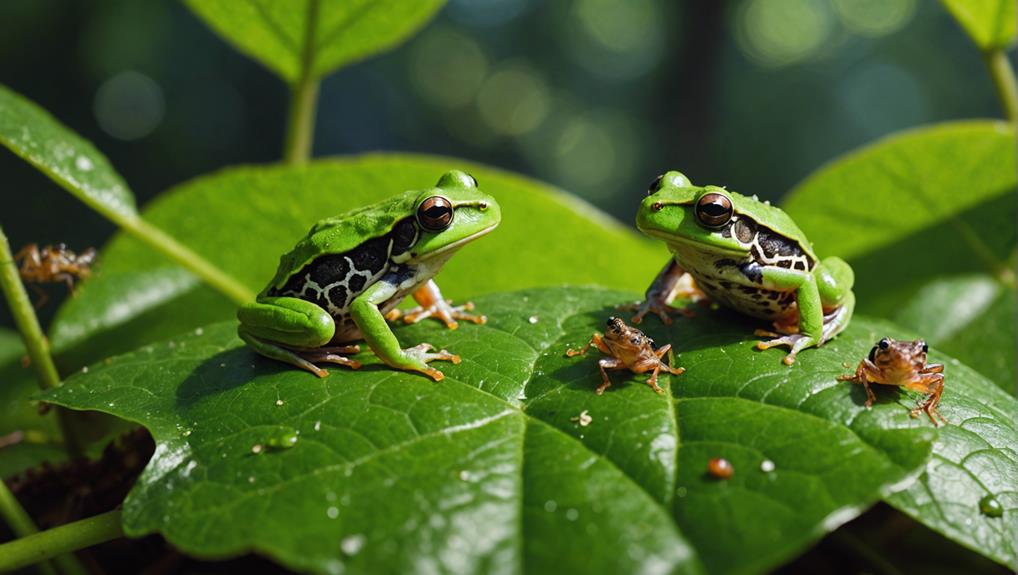
When choosing the best insects for baby frogs, think carefully about their size and nutritional value. Baby frogs, also known as froglets, need small, soft-bodied insects that are easy to digest and packed with nutrients.
Two excellent options to bear in mind are cricket varieties and ant larvae.
Cricket varieties, like pinhead crickets, are a popular choice for baby frogs. These tiny crickets are easy to find at pet stores and provide a good source of protein.
Verify that the crickets are no larger than the space between your froglet’s eyes to prevent choking and digestive issues. Feeding your froglets with appropriately sized crickets helps promote healthy growth and development.
Ant larvae are another fantastic option. They’re soft, small, and nutrient-rich, making them ideal for baby frogs. You can often find ant larvae in specialty pet stores or online.
When feeding ant larvae, be certain to offer them in moderation, as part of a varied diet, to guarantee your froglets receive balanced nutrition.
Nutritional Supplements
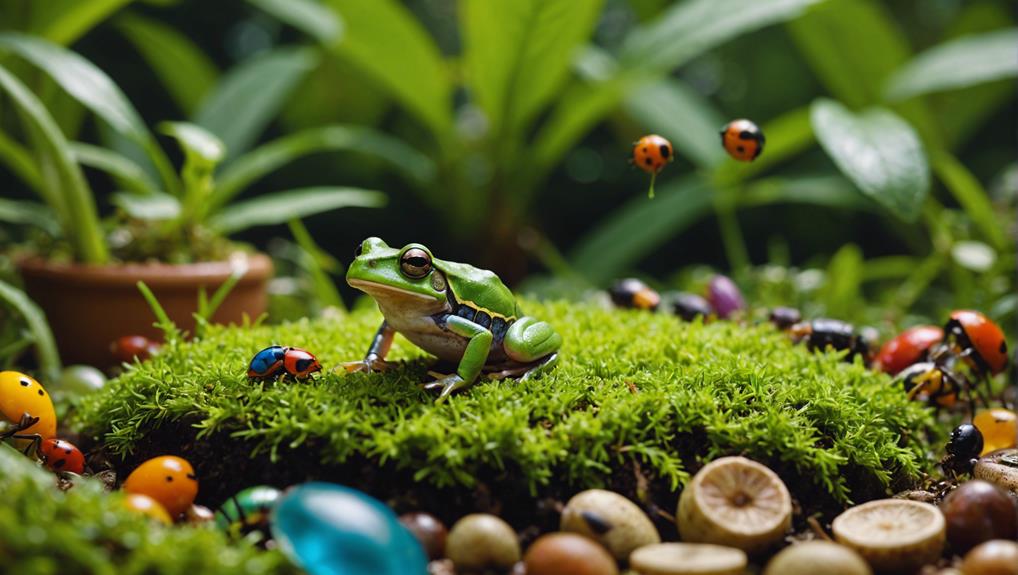
To guarantee baby frogs get all the essential nutrients they need, consider incorporating nutritional supplements into their diet. Baby frogs, like many young animals, require specific vitamins and minerals to support their rapid growth and development.
One way you can help provide these nutrients is by using vitamin powders. These powders can be sprinkled on the insects you feed your baby frogs, guaranteeing they receive a balanced diet.
Calcium supplements are equally important. Frogs need calcium for strong bone development and overall health. Without enough calcium, baby frogs may develop metabolic bone disease, which can be debilitating.
You can use calcium powders to dust their food, especially if you’re feeding them insects like crickets or mealworms that don’t naturally provide enough calcium.
When choosing supplements, look for those specifically formulated for amphibians to certify the right balance of nutrients. It’s also a good practice to alternate between vitamin powders and calcium supplements to avoid over-supplementation.
Feeding Frequency
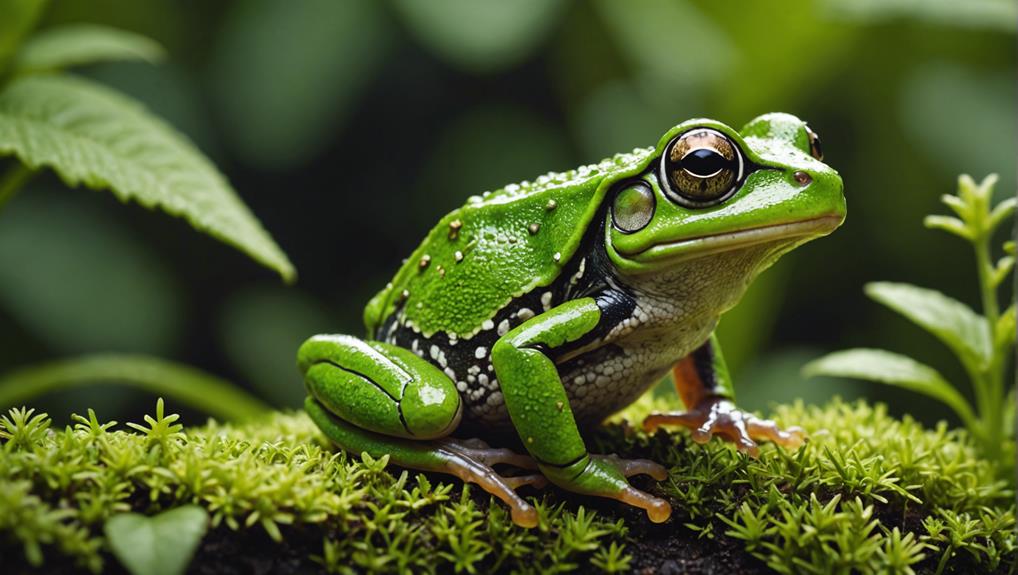
Baby frogs need to be fed small, frequent meals to support their rapid growth and high metabolism. Establishing a consistent timing schedule is vital for their development.
You should aim to feed them at regular intervals, typically two to three times a day. This guarantees they receive the nutrients they need without overwhelming their small digestive systems.
When setting up a feeding routine, consider the specific needs of your baby frogs. Younger frogs often require more frequent meals compared to older ones.
Start by offering food in the morning and then again in the afternoon. If they appear hungry in the evening, you can add an additional feeding session. Observing their behavior will help you fine-tune the timing schedules to suit their needs.
Regular feeding intervals not only aid in growth but also help in monitoring their health. By maintaining a routine, you can quickly notice any changes in their eating habits, which might indicate health issues.
Food Size and Preparation
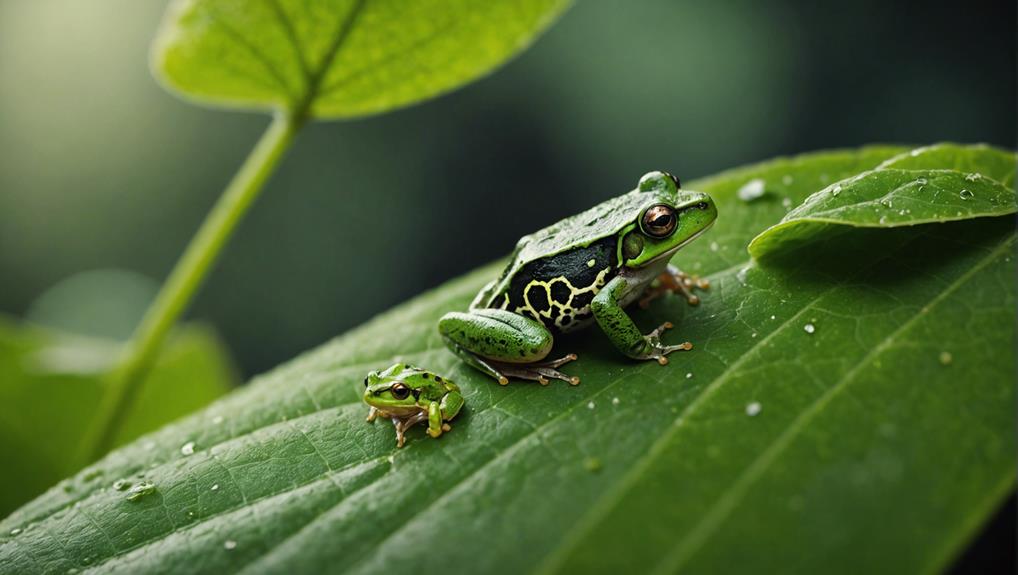
Ensuring the food is appropriately sized and properly prepared is essential for the health and development of baby frogs.
When feeding baby frogs, you need to think about food chopping and size variation. Tiny frogs can’t handle large prey, so cutting food into manageable pieces is vital. Aim for food items no larger than the width of the frog’s mouth. This makes it easier for them to eat and digest, reducing the risk of choking or digestive issues.
When preparing food, make certain it’s fresh and clean. For live prey, such as insects, you might need to chop them into smaller pieces depending on the frog’s size. For example, fruit flies are often suitable without further preparation, but larger insects like crickets or worms might require some chopping. Always observe your frogs during feeding to verify they can manage the food you provide.
Size variation is also important. Baby frogs grow quickly and their dietary needs change. Regularly adjust the size of the food to match their growth. By paying attention to food size and preparation, you’ll contribute substantially to the healthy development of your baby frogs, facilitating their thriving in their environment.
Safe Feeding Practices
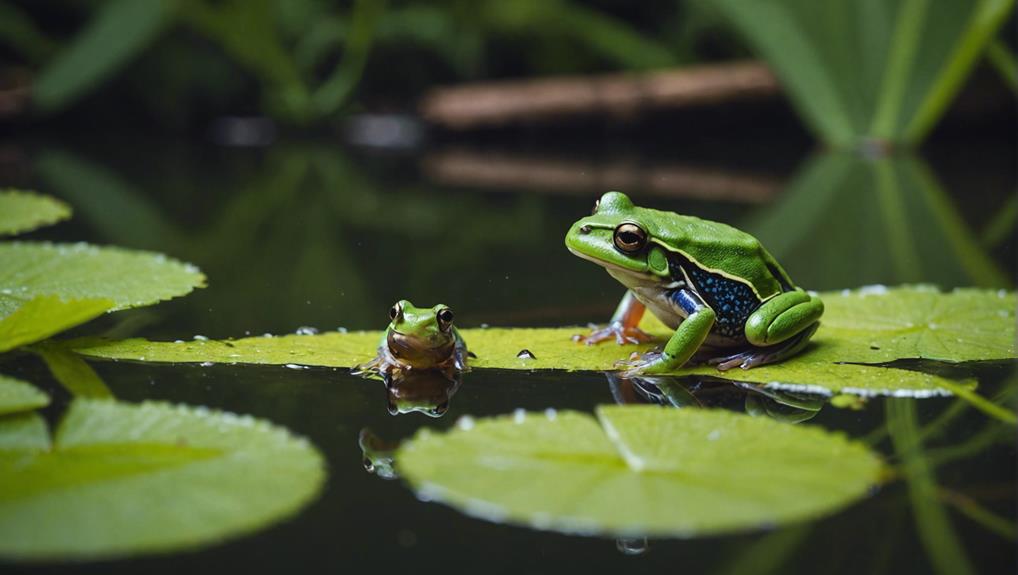
To guarantee your baby frog stays healthy, always provide clean water and avoid toxic foods.
It’s important to monitor feeding times closely to prevent overfeeding or underfeeding.
Provide Clean Water
Always make certain that the water provided to baby frogs is clean and free from contaminants to support their health and proper feeding. High water quality is vital for meeting their hydration needs and supporting their overall well-being.
Regularly change the water in their habitat to prevent the buildup of harmful substances. Use dechlorinated or spring water, as tap water often contains chemicals like chlorine and chloramine, which can be toxic to baby frogs.
Consider using a water conditioner to neutralize any impurities and make the water safer for your frogs. If you use a water filter, maintain it properly and clean it regularly to avoid introducing additional contaminants.
Monitoring the water quality regularly will help you detect any changes that could negatively impact your baby frogs.
Avoid Toxic Foods
Steer clear of feeding baby frogs any insects or foods that could be toxic to them. Identifying toxins in their diet is vital for their health and well-being.
When you’re feeding baby frogs, it’s imperative to avoid certain harmful items that could cause them serious harm or even death.
Some key things you should avoid:
Poisonous plants: Some plants contain toxins that are very harmful to baby frogs. Make sure any plants in their habitat are safe.
Wild-caught insects: These can carry pesticides or other harmful substances that mightn’t be apparent at first glance.
Insects with hard exoskeletons: Avoid beetles and other insects with hard shells that can be difficult for baby frogs to digest.
Monitor Feeding Times
Consistently monitoring feeding times is essential to guarantee baby frogs receive the proper nutrition they need to grow. By paying attention to feeding intervals and making necessary timing adjustments, you can promote healthy development and avoid overfeeding or underfeeding. Baby frogs typically need small, frequent meals, so establishing a regular feeding schedule is imperative.
Start by feeding your baby frogs once or twice a day, depending on their age and species. Observe their behavior and adjust the timing if needed. If they seem sluggish or uninterested in food, you might need to change the feeding intervals. Conversely, if they enthusiastically consume everything quickly, consider slightly increasing the amount or frequency.
It’s essential to remove uneaten food after each feeding session to prevent contamination and maintain a clean environment. This practice also helps you monitor their appetite and dietary needs more accurately. Consistent, timely feeding not only promotes healthy growth but also allows you to notice any changes in their eating habits that might indicate health issues.
Signs of Overfeeding
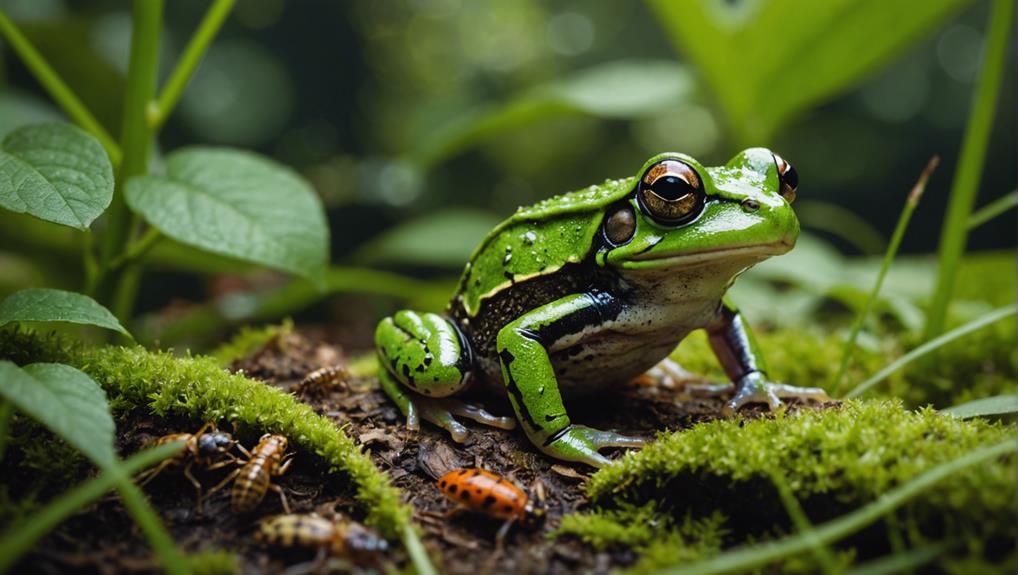
If you notice your baby frog becoming lethargic or bloated, it might be a sign of overfeeding.
Monitoring your baby frog’s health is crucial to ensure they’re growing properly. One of the first indicators of overfeeding is weight gain, which can lead to lethargic behavior. Excessive weight can put strain on their tiny bodies, making them less active and more prone to health issues.
Look out for these signs of overfeeding:
- Lethargic Behavior: Your frog might become less active and spend more time resting.
- Bloated Appearance: A visibly swollen stomach can indicate they’ve eaten too much.
- Refusal to Eat: If your baby frog starts refusing food, it might be because they’re already overfed.
Common Feeding Mistakes

Many new frog owners make common feeding mistakes that can impact their baby frog’s health.
One of the most frequent errors is failing to practice proper portion control. It’s easy to overfeed your baby frog, thinking more food equates to better growth. However, overfeeding can lead to obesity and other health issues. Always measure out appropriate portions and stick to a regular feeding schedule to maintain your frog’s health.
Another common mistake isn’t providing a variety balance in their diet. Baby frogs need a mix of different foods to get all the necessary nutrients. Relying on one type of food, like only feeding them crickets, can result in nutritional deficiencies. Make sure to incorporate a mix of insects, small invertebrates, and even specially formulated frog pellets to guarantee a well-rounded diet.
Additionally, some owners forget to remove uneaten food from the enclosure. Leftover food can rot and create an unhygienic environment, leading to potential health problems for your baby frog. Always check the enclosure after feeding and remove any uneaten food promptly.
Monitoring Growth and Health
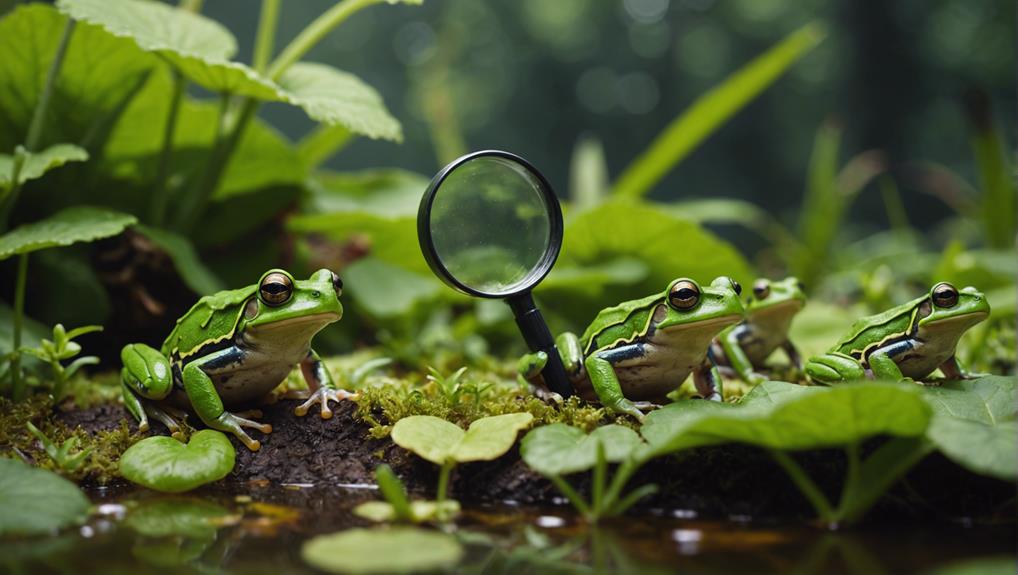
Regularly monitoring your baby frog’s growth and overall health is essential for its well-being. By keeping a close eye on your frog, you can catch any potential issues early and address them promptly.
To effectively monitor your frog, focus on weight tracking and regular health assessments.
Weekly weigh-ins are crucial. Use a small digital scale to track your frog’s weight every week. Consistent weight gain indicates good health, while sudden weight loss could signal a problem.
Regular visual inspections are also important. Check for signs of illness, such as changes in skin color, abnormal behavior, or physical deformities.
Behavioral monitoring is also key. Observe your frog’s eating habits and activity levels. A healthy frog is typically active and has a good appetite.
When conducting health assessments, confirm you’re looking for any abnormalities or signs of discomfort. Skin shedding is normal, but excessive shedding can indicate a problem. Similarly, labored breathing or lethargy should prompt a visit to the vet.
Conclusion
Ensuring your baby frog gets proper nutrition is like setting the stage for a lifelong symphony of health.
Stick to their natural diet, offer the best insects, and don’t forget nutritional supplements.
Feed them regularly but avoid overfeeding.
Practice safe feeding habits and watch for signs of mistakes.
Monitor their growth and health closely.
By following these guidelines, you’ll help your baby frog thrive, setting them up for a robust and vibrant life.
